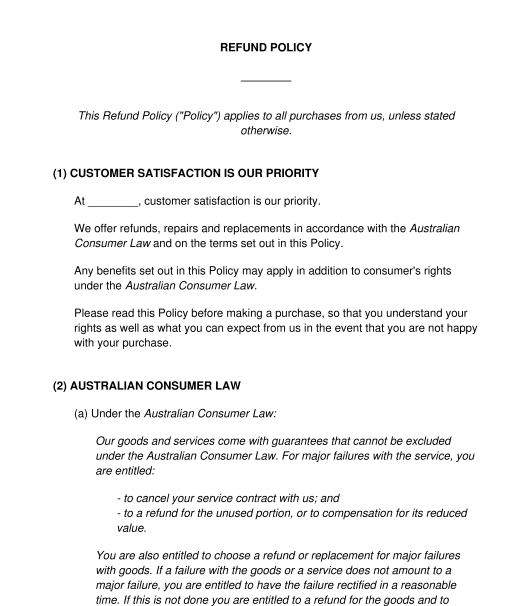 20/10/2025
20/10/2025

Answer a few questions and your document is created automatically.

Your document is ready! You will receive it in Word and PDF formats. You will be able to modify it.

A Refund Policy is a document which sets out how a vendor of goods or services deals with purchasers' requests for refunds (or repairs or replacements).
In a Refund Policy, the vendor explains when purchasers may be entitled to a refund, repair or replacement, when they may not, and what they can do to request one.
A Refund Policy sets out a business's general rules and approach to dealing with refunds. It is effectively a set of guidelines which the business follows.
A set of Terms and Conditions on the other hand, is the actual contract between the business and the customer. The customer either signs the Terms and Conditions, checks a box to confirm that they agree to the Terms and Conditions, or is notified that by making a purchase, they agree to be bound by the Terms and Conditions. There are a number of different types of Terms and Conditions such as a set of Terms and Conditions for Website or Mobile Application, a set of Terms and Conditions for Sale of Goods Online, or a Contract for Sale of Goods.
No, it is not mandatory to have a written Refund Policy. However, under Australian law, consumers have certain rights in relation to refunds (as well as repairs or replacements) that the business needs to honour regardless.
Therefore, most businesses find that having a written Refund Policy is worthwhile as it helps them to manage these obligations and to generate a positive relationship with their customers.
A Refund Policy should not contain provisions that attempt to take away a customer's legal right to a refund (or repair or replacement). Therefore, polcies that state "No Refunds" are likely to be illegal.
A Refund Policy can last indefinitely. However, businesses should routinely review their policies to ensure that they continue to reflect the current law and the business's processes and procedures.
The purchaser is not required to sign this document. Instead, it is provided to the purchaser at the point of purchase, so that the purchaser can be aware of the policy prior to buying anything from the vendor.
Once prepared, the document can be made available to purchasers, for example, by having it available at a point of sale, and/or posting a copy in a prominent place on the vendor's website (if the vendor is selling online).
A Refund Policy should contain:
For purchases that have been made after 1 January 2011, the Australian Consumer Law may apply, and may impose a set of minimum Consumer Guarantees.
For purchases prior to that date, the Trade Practices Act 1974 (Commonwealth) may apply, as well as state and territory fair trading laws.
In addition, any contracts for the sale and purchase of goods or services may be affected by general principles of contract law, as provided by the common law.
The Consumer Guarantees under the Australian Consumer Law require that:
Products must be of acceptable quality, that is:-
Acceptable quality takes into account what would normally be expected for the type of product and cost.
Products must also:-
Services must:-
You fill out a form. The document is created before your eyes as you respond to the questions.
At the end, you receive it in Word and PDF formats. You can modify it and reuse it.
A guide to help you: Do my Warranties against Defects Comply with the Changes to the Australian Consumer Law?
Refund Policy - sample template online - Word and PDF
Country: Australia